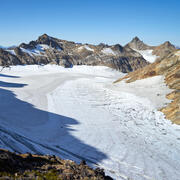Arctic
Global climate is influenced by the Arctic region, where ice reflects solar radiation and frozen soil contains more carbon than the atmosphere. The Ecosystems Land Change Science Program conducts research on long-term patterns and drivers of sea ice, permafrost, vegetation, and fire to document natural variability, understand impacts of humans, and anticipate future change.










